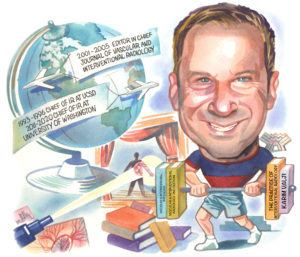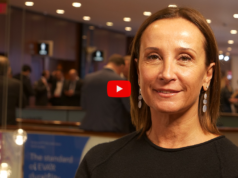“I took a giant leap of faith and applied for a radiology residency with the sole intention of doing interventional radiology (IR). I was lucky—it turned out to be the perfect specialty for me,” Karim Valji, professor of radiology at the University of Washington (Seattle, USA) and professor Emeritus at the University of California, San Diego (USA) tells Interventional News. Valji is also the former editor-in-chief of the Journal of Vascular and Interventional Radiology (JVIR).

What attracted you to a career in IR?
In medical school, I was drawn more towards the doctors who were ‘thinkers’ rather than ‘doers’. I started an internal medicine residency at UCSF [University of California, San Francisco], but by the end of my internship I realised that I really wanted to work in a procedure-driven field. Ernie Ring and Bob Kerlan were there running one of the premier IR sections in the country, and I watched them do several cases on my patients. Having spent no time whatsoever on an IR service, I took a giant leap of faith and applied for a radiology residency with the sole intention of doing IR. I was lucky–it turned out to be the perfect specialty for me.
Your 2020 Dotter Lecture focused on a fundamental question—why are we doing this procedure? Could you outline recurring scenarios in which this question should be at the forefront of a proceduralist’s mind?
In the busyness of our hectic workday, it is so easy just to do the cases listed on the board without stepping back to consider what we are really doing for every patient. We really need to have a different mindset. Like a surgeon, we must always start by looking at a patient’s clinical problem and consider how IR might benefit him or her. Sometimes it is as simple as deciding that a tunnelled catheter is more appropriate for this person than the port that was requested.
On one end of the spectrum are the referrals that require help with a complex situation. In that scenario, there may be a tendency to get swept up in the details of a proposed procedure—or a desperate patient or provider can make us feel compelled to do something. But we need to stop and ask these questions: Is the procedure likely to help the clinical situation? Are the potential benefits worth the risks? Is there a better option, perhaps even doing no intervention at all? And will it help the patient in the long run?
The polar opposite is the routine elective tube change. The case is totally mundane and so easy to do, but frankly, our responsibility goes beyond just changing out the catheter. We need to advocate for the patient and make sure there is a long-term plan that will, if possible and desired, allow the external catheter to come out. If that is not the case, we need to help the patient and family understand why the device may be in place for the long run. So, we must work with referring providers to advance treatment that will optimise the patient’s ultimate quality of life.
Having been the editor-in-chief of JVIR and having written three textbooks for IR, in 2022, what are ways to best educate the IR community?
Of course, when I started in IR over 30 years ago, the resources for learning the substance of IR were limited. To pick up the basics of interventional radiology, many current residents tell me that they still prefer print textbooks and ‘linear reading’ to study a particular topic or learn the fundamentals of our field more broadly. But frankly, I think many also rely more on various online sites for ‘bites’ of information that are short and well illustrated, and preferably interactive. While those sources are usually more enticing and up-to-date than print books, I do wonder about the accuracy of some of that material.
The quality of research being published in JVIR has never been higher. There is no better authority for learning about the newest advances in our field. However, I think we should always have a healthy dose of scepticism about any new technique or concept that we read about, even in venerated journals. In that same vein, I have found that many interventional radiologists (especially very experienced ones) can get dogmatic about the procedures they do and how they do them. It brings to mind the warning that a former dean at Harvard Medical School gave to an incoming class: “Half of what we are going to teach you is wrong and half of it is right. The problem is we do not know which half.”
What is your advice to a young trainee or interventional radiologist with an interest in academic medicine?
First, find a mentor—a person who can inspire you and guide you as you start doing research or getting involved in some other academic pursuit. It is not necessary to find someone with an international reputation or a CV a mile long. It is much more important to choose a person whom you respect and enjoy working with.
Second, if you have no experience with research, try your hand at a simple case report or short review article. Unfortunately, the sheer act of writing seems to turn off many aspiring young interventional radiologists. But, please believe that with some effort almost anyone can learn to write reasonably well.
Finally, do not reject the idea of academics simply because you think it means years of churning out papers. In many institutions, an interventional radiologist with an aptitude for teaching or an interest in leadership can have a rewarding and successful career as an educator or an administrator with minimal requirements for publication.
In the last few years, what research paper has particularly caught your attention?
In a JVIR article several years ago, my colleague Jeff Chick reported results of a national survey that he conducted to assess burnout among interventional radiologists. The findings were sobering. Burnout is a serious and growing concern for healthcare providers of every sort. Lack of energy, disengagement from colleagues, loss of satisfaction with work, a short temper with staff or even patients—these are some of the signs.
There certainly are a number of strategies for helping prevent or deal with burnout. But the first step is admitting to yourself that there may be a serious problem brewing, and that it should not be taken as a personal failure. Unfortunately, the ‘superman’ ethos that is common among interventional radiologists can make it hard to accept that reality.
At the very least, interventional radiologists concerned about their negativity towards work need to share these feelings with family or with close, trusted peers. And, just as important, all IR groups should confront this issue openly and directly, and make a real effort to identify and support colleagues who seem to be at risk.
What is one important way interventional radiologists can improve the quality of patient care they deliver?
Better communication. Not just with patients and families, but also with other providers who make up the medical team. Many surveys show that poor communication is one of the biggest complaints by the public about the modern healthcare system. We sometimes fail to be explicit about what a patient should expect during and after a procedure. Or, we do not provide clear and thorough information about how to manage a catheter, for example, when the patient is recovering. Or, we do not make it easy to reach us when a patient or family has concerns.
But on a broader level, the many individuals and teams caring for a patient sometimes give mixed or confusing messages about care plans and expectations for the future. The IR doctor gives the patient instructions about nephrostomy catheter management, and the IR nurse tells the family member something different. We do a complex venous reconstruction, but the procedure fails when another provider stops anticoagulation prematurely because the long-term plan was not well communicated. The problem is daunting. But we need to do our best to make the system work for each of our patients.
What gives you the most pleasure from travelling and teaching in different countries?
My most satisfying teaching experiences overseas have involved showing unknown cases to IR residents and fellows. These young trainees are so eager and grateful for teaching from someone from the USA who works in a leading centre for IR. And, any preconceived notions about the quality of training in some less-advantaged countries are quickly dispelled after a short time spent with some of their smart and enthusiastic interventional radiologists-to-be.
What are your interests outside medicine?
I am a voracious reader, gym junkie, and avid theatre-goer. My husband Jon and I spend as much time as we can visiting San Diego to see our two children and grandkids (now aged six, three, and one). And we are both lifelong travel fanatics. We spend hours and hours on Kayak putting together our own trips. We know exotic airport codes like sports fans know players’ stats. And our interests complement one another’s really well. I have made him appreciate all that world cities have to offer, and he entices me to places I could once barely find on a map…The Gambia, anyone?










